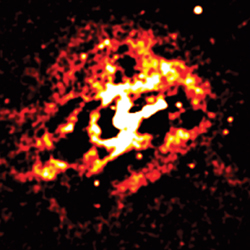
Chandra X-ray Observatory
NASA's Chandra X-ray Observatory, which was launched and deployed by Space Shuttle Columbia on July 23, 1999, is the most sophisticated X-ray observatory built to date.

M87 Core; about 50 million light years
The Instruments:
The Science Instrument Module (SIM) holds the two focal plane instruments, the Advanced CCD Imaging Spectrometer (ACIS) and the High Resolution Camera (HRC), moving whichever is called for into position during an observation.
ACIS consists of 10 CCD chips and provides images as well as spectral information of the object observed. It operates in the range of 0.2 - 10 keV. HRC has two micro-channel plate components and images over the range of 0.1 - 10 keV. It also has a time resolution of 16 microseconds. Both of these instruments can be used on their own or in conjunction with one of the observatory's two transmission gratings.
The transmission gratings, which swing into the optical path behind the mirrors, provide Chandra with high resolution spectroscopy. The High Energy Transmission Grating Spectrometer (HETGS) works over 0.4 - 10 keV and has a spectral resolution of 60-1000. The Low Energy Transmission Grating Spectrometer (LETGS) has a range of 0.09 - 3 keV and a resolution of 40-2000.

G292.0+1.8; about 20,000 light years; 142 hours of observation
Latest Discoveries:
# X-ray emissions from materials falling from a protoplanetary disc into a star.
# Hubble constant measured to be 76.9 km/s/Mpc using Sunyaev-Zel'dovich effect.
# 2006 Chandra found strong evidence that dark matter exists by observing supercluster collision
# 2006 X-ray emitting loops, rings and filaments discovered around a supermassive black hole within Messier 87 imply the presence of pressure waves, shock waves and sound waves. The evolution of Messier 87 may have been dramatically affected.
# Observations of the Bullet cluster put limits on the cross-section of the self-interaction of dark matter.
Hiç yorum yok:
Yorum Gönder